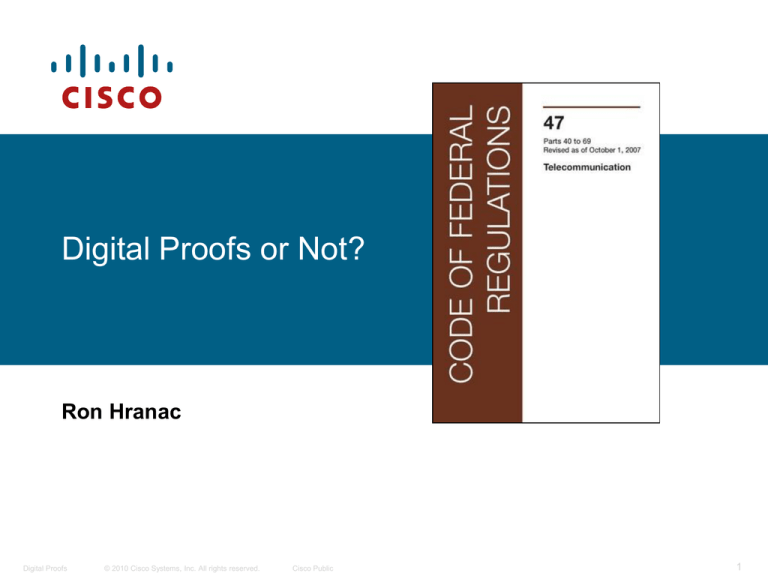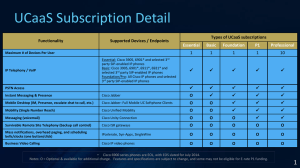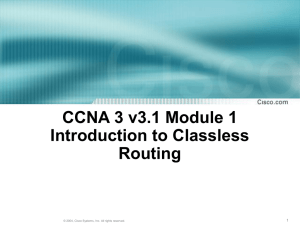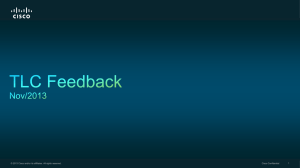
Digital Proofs or Not?
Ron Hranac
Digital Proofs
© 2010 Cisco Systems, Inc. All rights reserved.
Cisco Public
1
Digital Proofs or Not?
Did you know the FCC has required digital signals on
most cable networks to meet certain technical
performance parameters, and that this requirement has
been on the books for several years?
Graphics source: Sunrise Telecom
Digital Proofs
© 2010 Cisco Systems, Inc. All rights reserved.
Cisco Public
2
Digital Proofs or Not?
§76.640(b)(1)(i) is where
you’ll find the rules for digital
signals:
(1) Digital cable systems with an activated
channel capacity of 750 MHz or greater
shall comply with the following technical
standards and requirements:
(i) SCTE 40 2003 (formerly DVS 313):
“Digital Cable Network Interface Standard”
(incorporated by reference, see §76.602),
provided however that with respect to
Table B.11, the Phase Noise requirement
shall be −86 dB/Hz, and also provided that
the “transit delay for most distant customer”
requirement in Table B.3 is not mandatory.
Digital Proofs
© 2010 Cisco Systems, Inc. All rights reserved.
Cisco Public
3
Digital Proofs or Not?
This definitely causes a lot of confusion!
§76.640 of the FCC rules states that digital signals in 750
MHz and greater plants MUST meet the technical
parameters in SCTE-40.
The FCC rules don’t say when, how, or how often to
verify that digital signals are in compliance, nor do the
rules say how to document that compliance.
But those signals must comply—that part is clear.
Digital Proofs
© 2010 Cisco Systems, Inc. All rights reserved.
Cisco Public
4
Digital Proofs or Not?
The good news is that most of the QAM signal technical
parameters in SCTE-40 can be measured with commonly
available QAM analyzers (also known as digital signal
analyzers), spectrum analyzers, and signal level meters
(SLMs).
As we go through the requirements in SCTE-40, you’ll
notice that some of them apply to analog TV channels.
For the most part, those parameters mirror what is
required in §76.605 and other sections of the FCC rules.
This presentation highlights measurement techniques
applicable to QAM signals, since it is assumed that
measurements of analog TV channels are already being
done as part of FCC-required proof-of-performance
testing.
Digital Proofs
© 2010 Cisco Systems, Inc. All rights reserved.
Cisco Public
5
SCTE-40
6.4 Downstream Transmission Characteristics
The Downstream Transmission Characteristics are contained
in Table B. Analog and FAT1 Channel: RF Transmission
Characteristics and Table C. FDC2 Channel: RF
Transmission Characteristics as provided below. Analog and
FAT signals shall meet the characteristics specified in Table
B when measured on the subscriber's premises at the end of
a properly terminated drop cable and OOB FDC signals shall
meet the characteristics specified in Table C when measured
on the subscriber's premises at the end of a properly
terminated drop cable.
Note 1. Forward Application Transport (FAT) channels: 64- and 256-QAM channels that comply with
ITU-T J.83 Annex B, and are carried in the 54-864 MHz range.
Note 2. Forward Data Channels (FDC): Out-of-band QPSK signals located between 70 and 130 MHz
Digital Proofs
© 2010 Cisco Systems, Inc. All rights reserved.
Cisco Public
6
SCTE-40 Table B
Digital Proofs
© 2010 Cisco Systems, Inc. All rights reserved.
Cisco Public
7
SCTE-40 Table B (cont’d)
Digital Proofs
© 2010 Cisco Systems, Inc. All rights reserved.
Cisco Public
8
SCTE-40 Table B (cont’d)
Digital Proofs
© 2010 Cisco Systems, Inc. All rights reserved.
Cisco Public
9
SCTE-40 Table B (cont’d)
Digital Proofs
© 2010 Cisco Systems, Inc. All rights reserved.
Cisco Public
10
RF Channel Spacing
This is pretty much a yes or no requirement. If in doubt,
channel spacing is easily determined using a spectrum
analyzer.
Digital Proofs
© 2010 Cisco Systems, Inc. All rights reserved.
Cisco Public
11
RF Frequency Range
The first portion of this requirement is largely a fill-in-the-blanks
question. Specify the frequency range used for downstream
transmission.
The second portion of this requirement can be fulfilled by stating
the CEA 542-C channel plan—STD, IRC, or HRC—in use for
downstream transmission.
Channel
STD
(Analog
visual)
IRC
(Analog
visual)
HRC
(Analog
visual)
STD
(QAM CF)
IRC
(QAM CF)
HRC
(QAM CF)
2
55.2500
55.2625
54.0027
57.0000
57.0000
55.7500
3
61.2500
61.2625
60.0030
63.0000
63.0000
61.7500
4
67.2500
67.2625
66.0033
69.0000
69.0000
67.7500
5
77.2500
79.2625
78.0039
79.0000
81.0000
79.7500
6
83.2500
85.2625
84.0042
85.0000
87.0000
85.7500
Frequencies in table from CEA 542-C
Digital Proofs
© 2010 Cisco Systems, Inc. All rights reserved.
Cisco Public
12
Transit Delay (not required by FCC)
The SCTE-40 one-way transit delay specification is ≤0.800
millisecond (ms or msec)
Signals traveling one way from the headend to the subscriber
through, say, 18 km (59,055 feet) of fiber and 1 km (3,281 feet)
of coax: about 92 microseconds (μs or μsec) transit delay. This
is the same as 0.092 msec.
Coax serving area
Headend
Fiber
Node
18 km
1 km
~92 μs
Digital Proofs
© 2010 Cisco Systems, Inc. All rights reserved.
Cisco Public
13
Transit Delay (not required by FCC)
One can calculate the approximate one-way transit
delay (propagation delay) through a cable network. The
following pieces of information are required: the length
of transmission medium (fiber or coax) through which
the signals travel, and the velocity of propagation of the
transmission medium.
Typical velocity of propagation for single mode optical
fiber at 1310 nm is about 68%, and for hardline coaxial
cable the value is about 87%
The free space value of the speed of light is
299,792,458 meters per second, or 983,571,056.43
feet per second
Digital Proofs
© 2010 Cisco Systems, Inc. All rights reserved.
Cisco Public
14
Transit Delay (not required by FCC)
RF travels through hardline feeder cable at 87% of the free space
value of the speed of light, or 983,571,056.43 x 0.87 =
855,706,819.09 feet per second. The time it takes for RF to travel
through 1 foot of cable is 1.17x10-9 second (1.17 nanosecond)
Surprisingly, light travels through fiber slower than RF travels
through coax! For example, the published effective group index of
refraction for Corning’s SMF-28e+ optical fiber is 1.4676 at 1310
nanometers. That puts the velocity factor at 1/1.4676 = 0.6814,
and the velocity of propagation at just over 68%.
The light makes its way through the fiber at the leisurely pace of
670,190,144.75 feet per second, or through 1 foot of fiber in
1.49x10-9 second (1.49 nanosecond).
See “Velocity of Propagation” in the March 2010 issue of Communications Technology
magazine: http://www.cable360.net/ct/sections/columns/bullpen/40153.html
Digital Proofs
© 2010 Cisco Systems, Inc. All rights reserved.
Cisco Public
15
Carrier-to-Noise Ratio
The first part of this requirement applies to downstream QAM
signals.
The second part of this requirement applies to downstream
analog TV channels, and is the same as what is specified in
§76.605(a)(7) of the FCC rules:
(7) The ratio of RF visual signal level to system noise shall not be less than 43 decibels. For
class I cable television channels, the requirements of this section are applicable only to:
(i) Each signal which is delivered by a cable television system to subscribers within the predicted
Grade B contour for that signal;
(ii) Each signal which is first picked up within its predicted Grade B contour;
(iii) Each signal that is first received by the cable television system by direct video feed from a TV
broadcast station, a low power TV station, or a TV translator station.
Digital Proofs
© 2010 Cisco Systems, Inc. All rights reserved.
Cisco Public
16
Carrier-to-Noise Ratio (cont’d)
When using a spectrum
analyzer to measure the
carrier-to-noise ratio of a
QAM signal, the CNR is
simply the signal’s height
above the noise floor in dB.
Make certain that the spectrum
analyzer is displaying the cable
system’s noise floor, and not
the test equipment’s noise floor!
Digital Proofs
© 2010 Cisco Systems, Inc. All rights reserved.
Cisco Public
CNR ≈ 15 dB
This is the test
equipment’s noise floor,
not the system’s noise
floor. This is not a valid
CNR measurement!
17
Carrier-to-Noise Ratio (cont’d)
This example shows a CNR
of about 34 dB, which
exceeds the SCTE-40
requirements for both 64and 256-QAM
Digital Proofs
© 2010 Cisco Systems, Inc. All rights reserved.
Cisco Public
CNR ≈ 34 dB
18
CTB and CSO
Measuring composite triple beat and composite second
order in a QAM channel can be done one of two ways:
Turn off the QAM channel at the headend, and measure CTB and CSO
beat cluster levels in the field the same as is done to comply with
76.605(a)(8)(i) and (ii) of the FCC rules (note that SCTE-40’s
parameter is -53 dBc compared to the -51 dBc in the FCC rules). This
method is service disruptive.
Perform a non-disruptive measurement using test equipment that can
display the noise floor beneath an active QAM signal (example on next
slide).
Remember that SCTE-40’s CTB/CSO ratio measurements are relative
to analog TV channel levels
Digital Proofs
© 2010 Cisco Systems, Inc. All rights reserved.
Cisco Public
19
CTB and CSO
In a network with a lot of analog
TV channels, CTB beat clusters
will appear on visual carrier
frequencies, and CSO will appear
±0.75 and ±1.25 MHz relative to
visual carrier frequencies.
CSO
CSO
CTB
QAM signal’s
suppressed
carrier
Intermodulation
As the number of QAM signals
increases, CTB and CSO take on
a noise-like appearance called
composite intermodulation noise
(CIN), which cannot be
differentiated from thermal noise.
Graphics source: JDSU
Digital Proofs
© 2010 Cisco Systems, Inc. All rights reserved.
Cisco Public
20
Carrier-to-Interference (Ingress)
One can measure this SCTE-40 parameter using the
same method(s) used for CTB and CSO. What’s
unclear is the reference for the -53 dBc spec.
CSO
CSO
CTB
QAM signal’s
suppressed
carrier
Intermodulation
Graphics source: JDSU
Digital Proofs
© 2010 Cisco Systems, Inc. All rights reserved.
Cisco Public
21
AM Hum Modulation
While AM hum
modulation can be
measured on a CW
carrier, some QAM
analyzers support
automatic measurement
of hum on an active
QAM channel.
Graphics source: Sunrise Telecom
Digital Proofs
© 2010 Cisco Systems, Inc. All rights reserved.
Cisco Public
22
Group Delay Variation
0.25 µsec is the
same as 250 ns
A QAM signal’s inchannel group delay is
most easily measured
using a QAM analyzer
that supports this
parameter. The group
delay is derived from the
test equipment’s QAM
receiver adaptive
equalizer coefficients.
Graphics source: Sunrise Telecom
Digital Proofs
© 2010 Cisco Systems, Inc. All rights reserved.
Cisco Public
23
Chroma/Luma Delay
This is a parameter for analog TV channels that is
required to be measured in accordance with
§76.605(a)(11)(i):
(11) As of June 30, 1995, the following requirements apply to the performance of the cable
television system as measured at the output of the modulating or processing equipment
(generally the headend) of the system:
(i) The chrominance-luminance delay inequality (or chroma delay), which is the change in delay
time of the chrominance component of the signal relative to the luminance component, shall be
within 170 nanoseconds.
(ii) The differential gain for the color subcarrier of the television signal, which is measured as the
difference in amplitude between the largest and smallest segments of the chrominance signal
(divided by the largest and expressed in percent), shall not exceed ±20%.
(iii) The differential phase for the color subcarrier of the television signal which is measured as
the largest phase difference in degrees between each segment of the chrominance signal and
reference segment (the segment at the blanking level of O IRE), shall not exceed ±10 degrees.
Digital Proofs
© 2010 Cisco Systems, Inc. All rights reserved.
Cisco Public
24
Phase Noise
The FCC in §76.640(b)(1)(i) relaxed this requirement 2
dB from what is specified in SCTE-40, to -86 dB/Hz
Phase noise measurement is a service-disruptive
measurement that requires removing a QAM signal’s
modulation, leaving just a CW carrier on the channel’s
center frequency
A detailed procedure for phase noise measurement can
be found in NCTA Recommended Practices for
Measurements on Cable Television Systems, 3rd Ed.
(“Section 3.7 Phase Noise”)
Recommended Practices, 3rd Ed. is available from SCTE
Digital Proofs
© 2010 Cisco Systems, Inc. All rights reserved.
Cisco Public
25
In-Channel Frequency Response
The first part of this requirement applies to downstream
QAM signals.
The second part of this requirement applies to analog
TV channels, and is largely the same as what is
specified in §76.605(a)(6) of the FCC rules:
(6) The amplitude characteristic shall be within a range of ±2 decibels from 0.75 MHz to 5.0
MHz above the lower boundary frequency of the cable television channel, referenced to the
average of the highest and lowest amplitudes within these frequency boundaries. The amplitude
characteristic shall be measured at the subscriber terminal.
Digital Proofs
© 2010 Cisco Systems, Inc. All rights reserved.
Cisco Public
26
In-Channel Frequency Response (cont’d)
One can determine the approximate in-channel flatness
of a QAM signal by observing the flatness of the top of
the “haystack” on a spectrum analyzer.
A more accurate method is to use test equipment that
supports automated in-channel flatness measurement,
in which the results are typically derived from the test
equipment’s QAM receiver adaptive equalizer
coefficients.
Examples are included on the next two slides.
Digital Proofs
© 2010 Cisco Systems, Inc. All rights reserved.
Cisco Public
27
In-Channel Frequency Response (cont’d)
1.5 dB p-p
1.2 dB p-p
Graphics source: Agilent and Sunrise Telecom
Digital Proofs
© 2010 Cisco Systems, Inc. All rights reserved.
Cisco Public
28
In-Channel Frequency Response (cont’d)
This example
shows about 1 dB
peak-to-peak
amplitude variation
across the QAM
signal’s symbol
rate bandwidth
Graphics source: Sunrise Telecom
Digital Proofs
© 2010 Cisco Systems, Inc. All rights reserved.
Cisco Public
29
Micro-Reflections
A QAM analyzer’s adaptive equalizer graph (“equalizer
stress” graph) can be used to characterize microreflections.
An equalizer graph’s vertical axis usually shows relative
amplitude in decibels, and the horizontal axis shows
time, typically µsec.
Digital Proofs
© 2010 Cisco Systems, Inc. All rights reserved.
Cisco Public
30
Micro-Reflections (cont’d)
Graphics source: Sunrise Telecom
Digital Proofs
© 2010 Cisco Systems, Inc. All rights reserved.
Cisco Public
31
Micro-Reflections (cont’d)
-10 dB @ ≤0.5 µs
-15 dB @ ≤1.0 µs
-20 dB @ ≤1.5 µs
-30 dB @ ≤4.5 µs
0.5 µs 1.0 µs 1.5 µs
4.5 µs
The adaptive equalizer’s DFE taps (those
to the right of the main tap) should be
below the thresholds shown
Graphics source: Sunrise Telecom
Digital Proofs
© 2010 Cisco Systems, Inc. All rights reserved.
Cisco Public
32
Burst Noise
Section 3.6 of NCTA Recommended Practices for
Measurements on Cable Television Systems, 3rd Ed.,
describes three methods for measuring upstream
impulse noise. Method B or C should be able to be
adapted to downstream measurement of burst
(impulse) noise.
Note that SCTE-40 does not include an amplitude
reference for burst noise, per Table B’s Note 5: “Burst
noise is statistical in nature and a reference level
should be defined. Studies on this are continuing.”
Note: Recommended Practices, 3rd Ed. is available from SCTE
Digital Proofs
© 2010 Cisco Systems, Inc. All rights reserved.
Cisco Public
33
Signal Levels at Subscriber Terminal
The first two parameters of this requirement apply to
downstream QAM signals
The second two parameters of this requirement apply
to analog TV channels. Make sure the instrument used
for analog TV channel levels measures peak envelope
power (PEP). A properly calibrated SLM, QAM analyzer
with SLM functionality, or spectrum analyzer can be
used to measure analog TV channel signal levels.
Digital Proofs
© 2010 Cisco Systems, Inc. All rights reserved.
Cisco Public
34
Signal Levels at Subscriber Terminal
When we measure the RF level of QAM signals carried
on cable networks, we measure the entire signal’s
average power, also known as digital channel power.
Most modern SLMs, QAM analyzers, and some
spectrum analyzers support digital channel power
measurement, which removes the potential for error
when performing a manual measurement that requires
correction factors.
Examples are shown on the next slide.
Digital Proofs
© 2010 Cisco Systems, Inc. All rights reserved.
Cisco Public
35
Signal Levels at Subscriber Terminal
Graphics source: Sunrise Telecom & Agilent
Digital Proofs
© 2010 Cisco Systems, Inc. All rights reserved.
Cisco Public
36
Some Parting Thoughts
§76.640 has been on the books for several years. In
750 MHz and greater plants, downstream digital
signals must comply with SCTE-40. §76.640 does not
specify how often or when to measure QAM signal
performance, how many channels to test, or how to
make specific measurements. That section of the rules
says only:
“(1) Digital cable systems with an activated channel capacity of
750 MHz or greater shall comply with the following technical
standards and requirements:
(i) SCTE 40 2003 (formerly DVS 313): “Digital Cable Network
Interface Standard” (incorporated by reference, see
§76.602)…”
Digital Proofs
© 2010 Cisco Systems, Inc. All rights reserved.
Cisco Public
37
Some Parting Thoughts
My suggestion: Carefully read all of §76.640 and
SCTE-40, and adopt the necessary procedures to
ensure that you comply with what is stated.
Note that §76.640 refers to the 2003 version of SCTE-40. The
latter has since been updated, although the FCC rules do not
reference later versions.
Follow the test equipment manufacturers’
recommendations for appropriate factory calibration
requirements, warm-up time and field calibration before
performing all tests. These steps should be taken
immediately prior to the commencement of testing.
Digital Proofs
© 2010 Cisco Systems, Inc. All rights reserved.
Cisco Public
38
Some Parting Thoughts
Follow the test equipment manufacturers’ instructions
for specific digital measurements. Actual setup and
measurement procedures will vary among different
makes/models of test equipment.
Refer to NCTA Recommended Practices for
Measurements on Cable Television Systems, 3rd Ed.
for detailed how-to descriptions of several digital
measurement procedures.
Document everything!
Digital Proofs
© 2010 Cisco Systems, Inc. All rights reserved.
Cisco Public
39
Q and A
Digital Proofs
© 2010 Cisco Systems, Inc. All rights reserved.
Cisco Public
40
Backup slides
Digital Proofs
© 2010 Cisco Systems, Inc. All rights reserved.
Cisco Public
42
Distortions in an All-Digital Network
Distortions such as composite triple beat distortion,
composite second order distortion, and common path
distortion don’t go away in an all-digital network
Rather than clusters of discrete beats that occur in a network
carrying large numbers of analog TV channels, the digital
distortions are noise-like.
Those noise-like distortion products are variously known as
composite intermodulation noise (CIN), composite
intermodulation distortion (CID) or intermodulation noise
(IMN)—none of which should be confused with thermal noise.
Digital Proofs
© 2010 Cisco Systems, Inc. All rights reserved.
Cisco Public
43
Distortions in an All-Digital Network
Confusion does occur, though. We know that raising RF
levels in the plant improves the carrier-to-noise ratio, where
“noise” is thermal noise. But in a system with a lot of digital
signals, raising levels improves CNR to a point, then the
noise floor starts to increase and the CNR appears to get
worse.
That seems counterintuitive, but the now-elevated noise floor no
longer is just thermal noise. It’s a combination of thermal noise and
the previously mentioned noise-like distortions. When
characterizing plant performance in the presence of thermal noise
and CIN, the term “carrier-to-composite noise (CCN) ratio”
commonly is used. Indeed, CCN is a much more appropriate
measurement metric than is CNR under these circumstances,
because there is no practical way to differentiate thermal noise
from CIN.
Examples on the next three slides illustrate this
Digital Proofs
© 2010 Cisco Systems, Inc. All rights reserved.
Cisco Public
44
Distortions in an All-Analog Network
Visual carriers
Aural carriers
Thermal noise
CTB
CSO
For each 1 dB increase in system carrier levels:
•
•
•
Digital Proofs
CTB ratio degrades by 2 dB
CSO ratio degrades by 1 dB
CNR improves by 1 dB
© 2010 Cisco Systems, Inc. All rights reserved.
Cisco Public
45
Distortions in an Analog + Digital Network
Visual carriers
QAM signals
Composite noise
Thermal noise
Composite
intermodulation noise
CTB
CSO
For each 1 dB increase in system carrier levels:
•
•
•
Digital Proofs
CNR, CTB, & CSO ratios behave as before with all-analog operation
CIN ratio degrades by 1 to 2 dB (mix of 2nd & 3rd order components)
CCN ratio degradation depends on CIN and CNR values
© 2010 Cisco Systems, Inc. All rights reserved.
Cisco Public
46
Distortions in an All-Digital Network
Composite noise
Thermal noise
Composite
intermodulation noise
For each 1 dB increase in system carrier levels:
•
•
•
Digital Proofs
CNR behaves as before with all-analog operation
CIN ratio degrades by 1 to 2 dB (mix of 2nd & 3rd order components)
CCN ratio degradation depends on CIN and CNR values
© 2010 Cisco Systems, Inc. All rights reserved.
Cisco Public
47
Signal Leakage in an All-Digital Network
Leaking digital signals can cause harmful interference
to over-the-air services under the right conditions
Despite the fact that a QAM signal’s power is spread across
most of the 6 MHz channel bandwidth, moderate to high field
strength leaks involving those noise-like QAM signals can indeed
cause harmful interference.
6 MHz bandwidth
Communications transceiver’s
S9+15 dB S-meter reading caused
by 400 µV/m digital leak at 10 ft.
Digital Proofs
© 2010 Cisco Systems, Inc. All rights reserved.
Cisco Public
48
Signal Leakage in an All-Digital Network
The tens of thousands of existing leakage detectors out
in the field today cannot be used to measure leaking
digital signals
The good news is that manufacturers are working on digitalcompatible leakage-detector technology, and one manufacturer
recently introduced a digital-compatible leakage detection
product.
Until new digital-compatible leakage detection gear becomes
widely available, the only way to comply with the FCC’s existing
leakage rules and maintain compatibility with existing leakage
detectors is to use an analog TV channel or continuous wave
(CW) carrier when measuring leakage.
Digital Proofs
© 2010 Cisco Systems, Inc. All rights reserved.
Cisco Public
49









